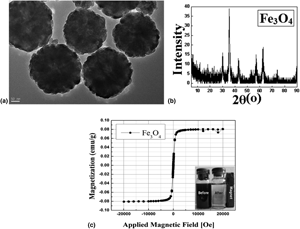Crossref Citations
This article has been cited by the following publications. This list is generated based on data provided by
Crossref.
Yang, Shuo
Li, Zhiwen
Zhang, Wenmeng
Lin, Meijin
and
Chen, Dongyang
2021.
Superhydrophobic coatings based on thermally and chemically stable fluorinated poly(aryl ether)/SiO2/carbon nanotube.
Journal of Materials Research,
Vol. 36,
Issue. 8,
p.
1705.
Pan, Lei
Xue, Pengbo
Wang, Menglin
Wang, Fei
Guo, Huaxin
Yuan, Xiaosa
Zhong, Lang
and
Yu, Jia
2021.
Novel superhydrophobic carbon fiber/epoxy composites with anti-icing properties.
Journal of Materials Research,
Vol. 36,
Issue. 8,
p.
1695.
Heidari, G
and
Hosseini, S I
2021.
Electrochemical fabrication of superhydrophobic and superoleophilic coating: applications in corrosion-resistant surfaces and oil cleanup.
Bulletin of Materials Science,
Vol. 44,
Issue. 4,
Farahat, Mohsen
Sobhy, Ahmed
and
Sanad, Moustafa M. S.
2022.
Superhydrophobic magnetic sorbent via surface modification of banded iron formation for oily water treatment.
Scientific Reports,
Vol. 12,
Issue. 1,
Makoś-Chełstowska, Patrycja
Słupek, Edyta
and
Małachowska, Aleksandra
2022.
Superhydrophobic sponges based on green deep eutectic solvents for spill oil removal from water.
Journal of Hazardous Materials,
Vol. 425,
Issue. ,
p.
127972.
Aras, Omur
Baydır, Enver
and
Akman, Bugra
2022.
Effect of pre-anodizing, electrocoating processes and fatty acid chain length on morphology, roughness and durability of ZnO-coated superhydrophobic surfaces.
Applied Physics A,
Vol. 128,
Issue. 3,
Zheng, Xiangyu
Zhang, Haiwei
Liu, Mengyue
Zhou, Xing
Wang, Hao
and
Jiang, Rijia
2022.
Porous sponge with surface modified for superhydrophobic/superoleophilic and special functionalization.
Journal of Polymer Research,
Vol. 29,
Issue. 6,
Sharma, Monika
Talukdar, Meenakshi
and
Deb, Pritam
2022.
High connectivity hierarchical porous network of polyurethane engineered by nanoflakes for proficient oil recovery.
Applied Surface Science,
Vol. 601,
Issue. ,
p.
154210.
Chen, Zhuohan
Su, Xiaojing
Wu, Wenjian
Chen, Siting
Zhang, Xiaofan
Wu, Yunhui
Xie, Huali
and
Li, Kunquan
2022.
Superhydrophobic PDMS@TiO2 wood for photocatalytic degradation and rapid oil-water separation.
Surface and Coatings Technology,
Vol. 434,
Issue. ,
p.
128182.
Sharma, Monika
Talukdar, Meenakshi
and
Deb, Pritam
2022.
High Connectivity Hierarchical Porous Network of Polyurethane Engineered by Nanoflakes for Proficient Oil Recovery.
SSRN Electronic Journal,
Zhou, Wuyifan
Yang, Feng
Yuan, Ling
Diao, Yangmin
Jiang, Ou
Pu, Yuan
Zhang, Yong
Zhao, Yong
and
Wang, Dan
2022.
Construction of Superhydrophobic Coating on Iron Surface with Enhanced Anti-Corrosion, Anti-Adhesive and Anti-Bacterial Properties.
Materials,
Vol. 15,
Issue. 23,
p.
8634.
Tekin, Zeynep
Özdoğan, Nizamettin
Karlıdağ, Nazime Ebrar
and
Bakırdere, Sezgin
2023.
Stearic Acid Functionalized Iron Nanoparticle Based Magnetic Solid-Phase Extraction (MSPE) for the Determination of Oxadiazon in Purslane by High-Performance Liquid Chromatography (HPLC).
Analytical Letters,
Vol. 56,
Issue. 1,
p.
120.
da Costa, Juliê S.
and
Fajardo, André R.
2023.
Polypyrrole/stearic acid-coated Luffa cylindrica for enhanced removal of sodium diclofenac from water: Batch and continuous adsorption studies.
Journal of Cleaner Production,
Vol. 389,
Issue. ,
p.
136084.
Li, Xinyi
Yang, Kangli
Yuan, Zhiqing
Liu, Shujuan
Du, Juan
Li, Cancheng
and
Meng, Shoutong
2023.
Preparation and properties of a superhydrophobic surface on the printed circuit board (PCB).
Applied Physics A,
Vol. 129,
Issue. 6,
Medinger, Joelle
Song, Kyung Seob
Umubyeyi, Pacifique
Coskun, Ali
and
Lattuada, Marco
2023.
Magnetically Guided Synthesis of Anisotropic Porous Carbons toward Efficient CO2 Capture and Magnetic Separation of Oil.
ACS Applied Materials & Interfaces,
Vol. 15,
Issue. 17,
p.
21394.
Guo, Zhibiao
Wang, Mingkun
Qiao, Lei
Wang, Jianxiang
and
He, Zhiwei
2023.
Photothermal, Magnetic, and Superhydrophobic PU Sponge Decorated with a Fe3O4/MXene/Lignin Composite for Efficient Oil/Water Separation.
Langmuir,
Vol. 39,
Issue. 47,
p.
16935.
Li, Chao
Yun, Tongtong
Pan, Gaofeng
Tao, Yehan
Lu, Jie
Du, Jian
and
Wang, Haisong
2023.
Tailoring flower-like Zn(OH)2 nanoarchitectures and stearic acid on cellulosic fibers for structurally robust superhydrophobic surface.
Industrial Crops and Products,
Vol. 205,
Issue. ,
p.
117576.
Bhagwat, Sanjay B.
Jaspal, Dipika
Tiwari, Amit Kumar
Malviya, Arti
and
Petrounias, Petros
2024.
Sustainable polyurethane for the remediation of oil spills: a review.
Environmental Science and Pollution Research,
Vol. 31,
Issue. 19,
p.
27509.






